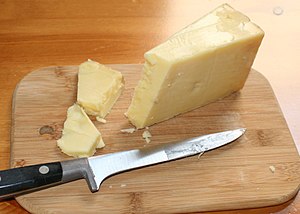Cheddar cheese
Cheddar cheese is a popular type of cheese known for its distinctive taste, smooth texture, and versatility in culinary applications. Named after the English village of Cheddar, where it originated, this cheese has gained worldwide popularity and is enjoyed in a variety of dishes. In this article, we will explore the characteristics of cheddar cheese, its nutritional profile, and ways to incorporate it into your meals.
Characteristics of Cheddar Cheese
Cheddar cheese is a semi-hard cheese made from cow's milk. It undergoes a process of cheddaring, which involves stacking and turning the curds to expel whey and develop its characteristic texture and flavor. Cheddar cheese typically has a pale to medium yellow color, although variations such as white cheddar also exist. Its flavor can range from mild and buttery to sharp and tangy, depending on factors such as aging time and production techniques.
Nutritional Profile
- Cheddar cheese provides various essential nutrients, including:
- Protein: Cheddar cheese is a good source of high-quality protein, which is essential for building and repairing tissues, supporting immune function, and maintaining overall health.
- Calcium: Cheddar cheese is rich in calcium, a mineral vital for strong bones and teeth, as well as proper nerve function, muscle contraction, and blood clotting.
- Vitamin A: Cheddar cheese contains vitamin A, which is important for vision, immune function, and cell growth and differentiation.
- Vitamin B12: Cheddar cheese is a source of vitamin B12, which is essential for the production of red blood cells, nerve function, and DNA synthesis.
- Phosphorus: Cheddar cheese is a good source of phosphorus, which plays a crucial role in bone health, energy metabolism, and various cellular processes.
- It's important to note that cheddar cheese is also high in saturated fat and sodium, so it should be consumed in moderation as part of a balanced diet.
Culinary Uses
- Cheddar cheese's versatility makes it a staple ingredient in many dishes. Here are some popular culinary uses for cheddar cheese:
- Sandwiches and Burgers: Cheddar cheese adds a delicious and melty element to sandwiches, burgers, and sliders. It pairs well with various fillings and toppings.
- Macaroni and Cheese: Cheddar cheese is a classic choice for macaroni and cheese, providing a creamy and flavorful base for this beloved comfort food.
- Cheeseboards and Platters: Cheddar cheese can be featured on cheeseboards and platters, accompanied by fruits, nuts, crackers, and charcuterie.
- Baked Goods: Cheddar cheese can be incorporated into baked goods, such as biscuits, scones, and savory muffins, to add richness and flavor.
- Cheese Sauces: Cheddar cheese is commonly used in cheese sauces for dishes like nachos, enchiladas, and casseroles, providing a cheesy and creamy element.
- Grilled Cheese Sandwiches: Cheddar cheese's melting properties make it an excellent choice for grilled cheese sandwiches, where it pairs well with various breads and other fillings.
- Soups and Stews: Cheddar cheese can be grated or melted into soups and stews, adding a rich and savory flavor.
- Snacks: Cheddar cheese can be enjoyed on its own as a snack or combined with crackers, fruits, or vegetables for a tasty and satisfying bite.
Also see
This is a short summary article. For quality control, we do not encourage or allow strangers to edit the content.
